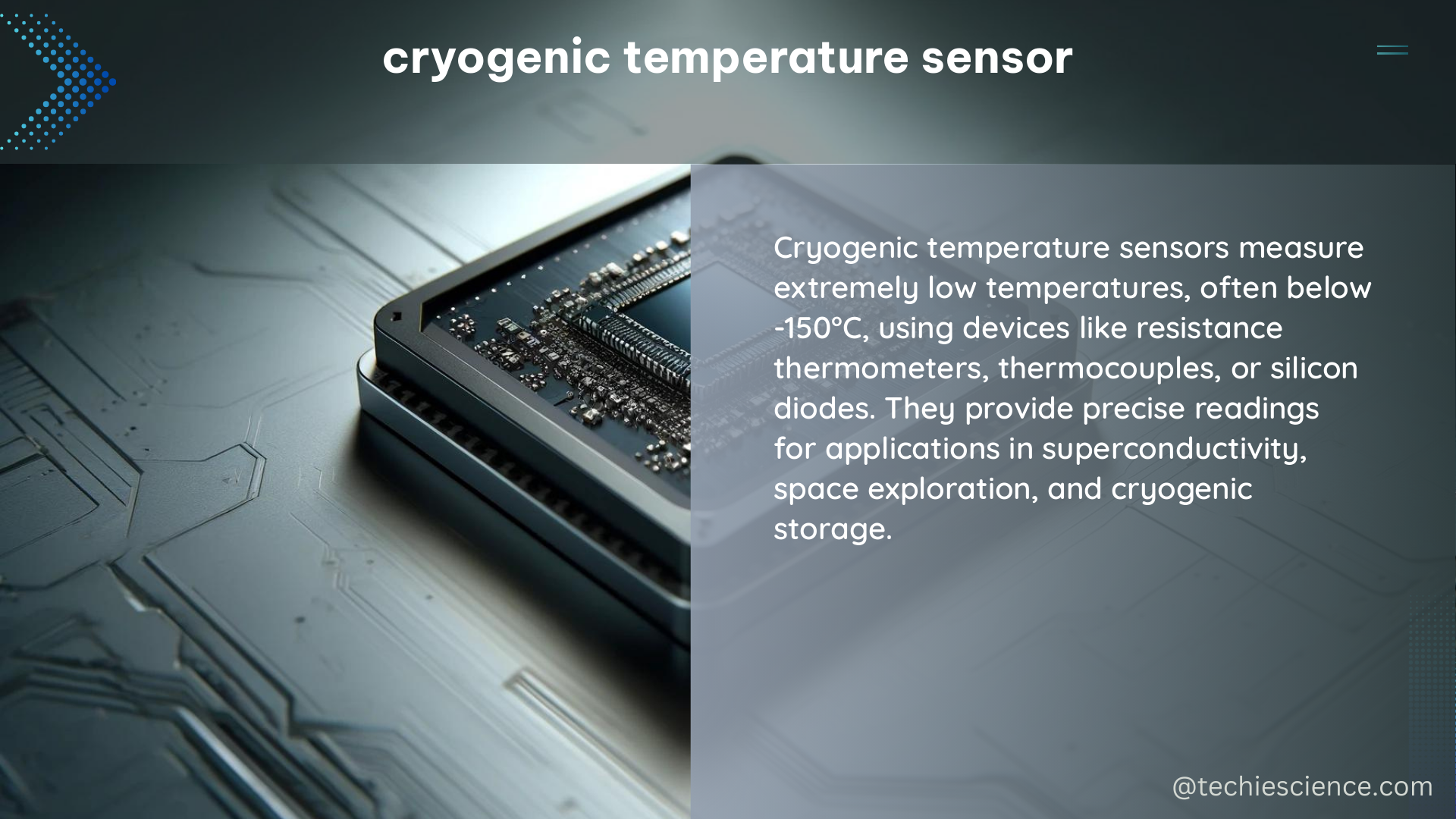Cryogenic temperature sensors are specialized devices designed to measure temperatures in extreme cold environments, typically below -150°C or 123 K. These sensors are crucial in various fields such as aerospace, physics, and engineering, where precise temperature measurements are required in low-temperature applications.
Types of Cryogenic Temperature Sensors
There are several types of cryogenic temperature sensors, each with its own unique characteristics and applications:
- Resistance Thermometers:
- Cernox Sensors: These are widely used due to their high accuracy, stability, and resistance to magnetic fields. Cernox sensors can operate at temperatures below 4.2 K with low magnetic field-induced calibration offsets, making them suitable for high energy physics projects.
- Platinum Resistance Thermometers (PRTs): PRTs are known for their excellent stability and repeatability, making them a popular choice for cryogenic temperature measurement. They can operate in the range of 0.65 K to 1,235 K.
-
Carbon-Glass Resistance Thermometers: These sensors offer a wide temperature range, from 0.03 K to 325 K, and are often used in applications where high magnetic fields are present.
-
Thermocouples:
- Type E Thermocouples: These are composed of chromel and constantan, and they are suitable for cryogenic temperature measurement in the range of 1.2 K to 1,235 K.
-
Type T Thermocouples: Made of copper and constantan, these thermocouples are commonly used for cryogenic temperature measurement, with a range of 1.2 K to 673 K.
-
Diodes:
- Silicon Diodes: Silicon diodes can achieve highly accurate cryogenic temperature measurements with an absolute accuracy of ±0.20°R or better over a specified range, thanks to software calibration.
- Germanium Diodes: Germanium diodes are known for their high sensitivity and are often used in applications where precise temperature measurement is required, such as in superconducting magnets.
Accuracy and Calibration of Cryogenic Temperature Sensors

The accuracy of a cryogenic temperature sensor is a critical parameter. Factors that affect the accuracy include sensor type, calibration, and installation practices.
Sensor Accuracy
- Cernox sensors can achieve an accuracy of ±0.1 K or better in the temperature range of 4 K to 325 K.
- Platinum Resistance Thermometers (PRTs) can achieve an accuracy of ±0.01 K or better in the range of 0.65 K to 1,235 K.
- Silicon diodes can achieve an absolute accuracy of ±0.20°R or better over a specified range through software calibration.
Calibration
Cryogenic temperature sensors must be calibrated to ensure their accuracy. Calibration is typically performed using reference standards, such as the International Temperature Scale of 1990 (ITS-90), which defines temperatures down to a lower limit of 0.65 K.
The National Institute of Standards and Technology (NIST) offers calibration services for cryogenic resistance thermometers over the range of 0.65 K to 165 K. The calibration process involves comparing the sensor’s output to a reference standard, and the resulting calibration data is used to correct the sensor’s readings.
Installation Practices
Good design and installation practices are essential in achieving accurate temperature measurements. Factors such as sensor placement, thermal anchoring, and shielding from external influences can all impact the sensor’s performance.
Applications of Cryogenic Temperature Sensors
Cryogenic temperature sensors are used in a wide range of applications, including:
-
Aerospace: Cryogenic temperature sensors are used in spacecraft and satellite systems to monitor the temperature of cryogenic propellants, superconducting electronics, and other critical components.
-
Physics Research: Cryogenic temperature sensors are essential in high-energy physics experiments, such as those conducted at particle accelerators, where they are used to monitor the temperature of superconducting magnets and other sensitive equipment.
-
Cryogenic Storage and Transport: Cryogenic temperature sensors are used to monitor the temperature of liquefied gases, such as liquid nitrogen and liquid helium, during storage and transport to ensure the integrity of the cryogenic materials.
-
Superconducting Electronics: Cryogenic temperature sensors are used to monitor the temperature of superconducting electronics, such as those found in magnetic resonance imaging (MRI) systems and quantum computing devices.
-
Cryogenic Instrumentation: Cryogenic temperature sensors are used in a variety of cryogenic instrumentation, including cryostats, dilution refrigerators, and other specialized equipment used in low-temperature research and development.
Conclusion
Cryogenic temperature sensors are essential tools for measuring temperatures in extreme cold environments. With their specialized design and high accuracy, these sensors play a crucial role in a wide range of applications, from aerospace to physics research and beyond. By understanding the different types of cryogenic temperature sensors, their accuracy and calibration requirements, and their various applications, researchers and engineers can ensure that they are using the right tools for the job and obtaining the most reliable and accurate temperature measurements possible.
References:
- Cryogenic Measurements: A Review of Cryogenic Sensor Technologies and Their Applications
- NIST Special Publication 250-91: Calibration of Cryogenic Temperature Sensors and Evaluation of Sensor Performance
- Application Note: Cernox Sensors for High Energy Physics
- Cryogenic Temperature Sensors for Space Applications

The lambdageeks.com Core SME Team is a group of experienced subject matter experts from diverse scientific and technical fields including Physics, Chemistry, Technology,Electronics & Electrical Engineering, Automotive, Mechanical Engineering. Our team collaborates to create high-quality, well-researched articles on a wide range of science and technology topics for the lambdageeks.com website.
All Our Senior SME are having more than 7 Years of experience in the respective fields . They are either Working Industry Professionals or assocaited With different Universities. Refer Our Authors Page to get to know About our Core SMEs.